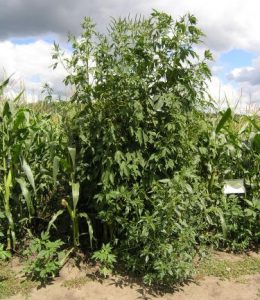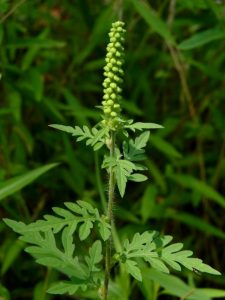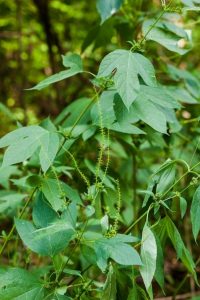Kaitlyn Lance
Agriculture Educator
Extension La Crosse County
For those with allergies and those who work in crop fields, ragweed is a very well-known pest. Two of the most common types we have in the area include Common and Giant Ragweed. In this report, I will discuss identifying the plant, ways to control it, and mention some research coming down the pipeline. There will be two sections – one for homeowners and one for crop farmers/livestock owners with pasture. The information used in this article comes from The University of Wisconsin – Madison Agronomy Department, UW Madison -Division of Extension, University of Illinois – Extension, and Purdue Extension. More information about any of these resources can be found in the Works Cited section.
Ragweed Description
 |
 |
| Photo Credit: Wikimedia | Photo Credit: Missouri State |
|
Common Ragweed Root: Branched Taproot Stem/Height: Hairy and Branched, Rough Textured. Can grow to 2 to 3 feet tall Leaves: Pinnately Compound; Lower eaves opposite, Middle and upper leaves alternate Flower: Inconspicuous; Monoecious
|
Giant Ragweed Root: Branched Taproot Stem/Height: Hairy and Branched, Rough Textured. Can grow 4 to 12 feet tall Leaves: Three-lobed, Large, Mostly opposite Flower: Inconspicuous; Monoecious
|
 |
 |
| Photo Credit for Common Ragweed Leaf: Flickr | Photo Credit Giant Ragweed Leaf: Flickr |
Homeowner Control
Ragweed is a weed of opportunity. It thrives in disturbed soil and can tolerate poor growing conditions. The first step to controlling any weed is to have it properly identified. You can use the description and pictures above or contact your local Extension educator to assist with identification. What life stage the ragweed is in will determine what type of control you will need to do. When it’s small, less than 4 to 6 inches tall, herbicides such as 2-4D may be used, larger plants may not die from herbicide applications. Caution must be considered when utilizing herbicides, ragweed can quickly build up tolerance to herbicide use. Switch up your weed management year to year so the ragweed and other troublesome weeds do not build up tolerance. It is also very important to follow the exact instructions found on the herbicide label, including personal safety equipment. Using herbicides off label can have serious consequences.
Other ways of control as quoted from the University of Illinois State Master Gardener coordinator Sandra Mason is to:
- “Cut, cultivate, or pull ragweed so they do not ‘go to seed’ to help reduce their population.
- Next season mulch the area and remove plants in May or June before flowering.” This will help to reduce the population of ragweed in your lawn or garden.
- Ragweed seeds can last up to thirty years in the soil – not disturbing the soil, practicing no till and mulching can aid in reducing the number of ragweed plants you have.
Since ragweed is just one type of plant that can cause allergies and it can affect everyone differently, it is important that you discuss it with your local health care professional.
Crop/Pasture Management of Ragweed for Farmers
As mentioned in the Homeowner section, ragweed is very opportunistic. In a survey of 64 soybean fields located in ten counties from southwest to east central Wisconsin, it was found that Common Ragweed was among the most abundant broadleaf weed species, present in 53% of all fields (Fickett et al. 2013).
Research into herbicide resistance of Common Ragweed has found that there are cases of resistance to multiple types of herbicide such as glyphosates, ALS inhibitors, and protoporphyrinogen oxidase (PP0) inhibitors (Group 14).
There are several management strategies available to crop and pasture managers to reduce the number of herbicide – resistant weeds and reduce their persistence and spread. Below are a few suggestions:
- Understanding the biology of weeds present and using a diversified approach to managing those weeds with the intent to prevent weed-seed production. This can include mowing, herbicides, crop rotation, and tillage
- Using weed-free crop seed and planting into weed-free fields.
- Scouting fields routinely to aid in identifying potential weed management issues.
- Using multiple herbicide sites of action at the labeled rates and at recommended weed heights. Applying herbicides to weeds that are too big is a common reason why herbicide applications failed.
- Cleaning equipment after use to prevent spread of weed seed from field to field.
Conclusion
As a homeowner or farmer, there are several ways to help reduce the spread of both Common and Giant Ragweed. This article is just a quick guide; the references below dive deeper into management practices. If any additional questions arise, please reach out to your local Extension educator.
References
- Doll, Jerry, et al. “The Dirty Dozen and Beyond: Identifying and Managing 25 Pasture Weeds of Wisconsin.” The Learning Store, University of Wisconsin-Extension, 2004, learningstore.extension.wisc.edu/products/dirty-dozen-and-beyond-identifying-and-managing-25-pasture-weeds-of-wisconsin-the-p165?_pos=1&_sid=2d1252bbd&_ss=r.
- Jordan, Tom, et al. “Biology and Management of Common Ragweed.” Weed Science Extension Publication. Division of Plant Science, University of Missouri, weedscience.missouri.edu/publications/gwc-14.pdf.
- Mason, Sandra. “The Homeowners Column.” Identifying Irritating Ragweed – The Homeowners Column – University of Illinois Extension Serving Champaign, Ford, Iroquois and Vermilion Counties, University of Illinois – Extension, web.extension.illinois.edu/cfiv/homeowners/150827.html.
- Zimbric, Joe, and Dave Stoltenberg. “Glyphosate Resistance Confirmed in Common Ragweed from Columbia County, Wisconsin.” Integrated Pest and Crop Management, Integrated Pest and Crop Management, University of Wisconsin-Madison, 19 Dec. 2018, ipcm.wisc.edu/blog/2018/12/glyphosate-resistance-confirmed-in-common-ragweed-from-columbia-county-wisconsin-2/.
- Reviewed by Bill Halfman, Agriculture Agent for University of Wisconsin – Madison, Division of Extension Monroe County.



